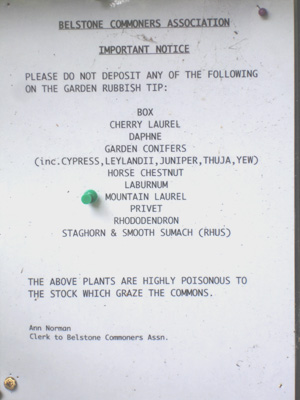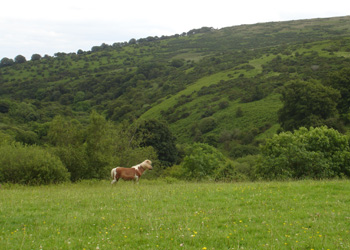
Adjacent is a public notice from the Belstone Commoners Association urging villagers not to tip plant cuttings that might be injurious to livestock on the garden waste heap.
If you are unfamiliar with the traditions of the Dartmoor Commons, you may wonder who these commoners are and what they get up to (apart from issuing edicts).
From at least the 13th Century, the villagers of 24 parishes surrounding the Forest of Dartmoor, including Belstone, were granted venville rights in exchange for paying rents to the Duchy of Cornwall who owned the Forest of Dartmoor. The word venville is derived from the Latin fines villarum, meaning a variable sum to be paid by members of a settlement for use of common resources. Those who lived within the Forest of Dartmoor held commoners rights unconditionally and did not have to pay rent. The original rights covered all things that may do them good except vert (green oak) and venison.
Over the centuries, these rights have come to include:
From time to time disputes over these rights have arisen. As recently as 1922 a group of angry Belstone Commoners flouted an order by the Duchy of Cornwall prohibiting the removal of peat from the commons. Representatives of the Duchy were nowhere to be seen, but the protest was observed by the Western Times who reported
Most of these rights persist to the present day, now under the control of the Dartmoor Commoners Council, set up in 1965, and the Dartmoor National Park Authority. The people who can exercise these rights today are known simply as commoners. As related in The Book of Belstone, parishioners were encouraged to register as commoners under the Commons Registration Act, 1965
Frank Woodward, who devoted much time to ensuring that Belstonians understood and took proper benefit from the Act, explained:

Like common land everywhere, the Dartmoor commons are all owned by someone but are subject to rights of commoners. The Commons Registration Act required the registration of common land nationally, its ownership, and the extent and nature of the rights held. Today, on Dartmoor, there are 92 separate common land units coming under some 54 different owners and there are about 850 registered commoners.
Rights are attached to specific properties for keeping certain numbers of sheep, cattle and ponies. These rights are registered and depend on the size of the farm. On Dartmoor, rights of grazing exist for some 145,000 sheep, 33,000 cattle, 5,450 ponies and 12,330 other potential grazing units. In practice the numbers actually grazed are much smaller. The rights are retained when the registered properties are sold.
In 1990, The Dartmoor Commoners' Council drew up Regulations governing the commoners' activities. They are required to comply with these stipulations:
